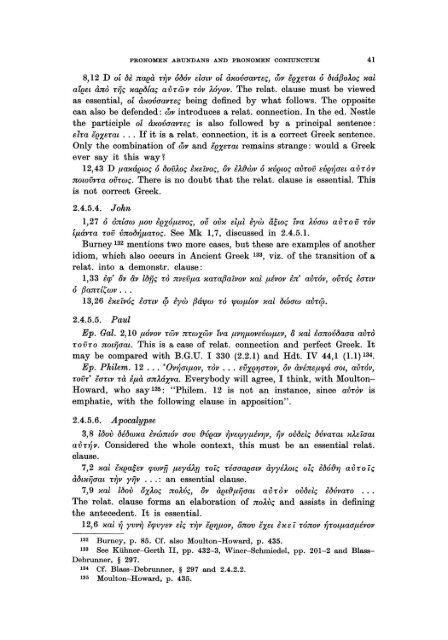Pronomen Abundans and Pronomen Coniunctum. A ... - DWC
Pronomen Abundans and Pronomen Coniunctum. A ... - DWC
Pronomen Abundans and Pronomen Coniunctum. A ... - DWC
Create successful ePaper yourself
Turn your PDF publications into a flip-book with our unique Google optimized e-Paper software.
PRONOMEN ABUNDANS AND PRONOMEN CONIUNCTUM 41<br />
8,12 D oE ~è naeà Tijv ó~6v elatv oE à"ovaavn:ç, wv lexeTat ó ~tá{3o),oç "ai<br />
aieet à:n:d TijÇ "aeMaç aVTwv Tdv )'6yov. The relat. clause must be viewed<br />
as essential, oE à"ovaavn:ç being defined by what follows. The opposite<br />
can also be defended : wv intro duces arelat. connection. In the ed. NestIe<br />
the participle oE à"ovaavn:ç is also followed by a principal sentence:<br />
elTa lexe'Wt ... If it is arelat. connection, it is a correct Greek sentence.<br />
Only the combination of wv <strong>and</strong> lexe'Wt remains strange: would a Greek<br />
ever say it this way 1<br />
12,43 D fla"áetoç ó ~ov),oç è"ûvoç, OV è).{)wv ó "vetoç aVTov eve~aet aVTdv<br />
notoVv'W OVTCOÇ. There is no doubt that the relat. clause is essential. This<br />
is not correct Greek.<br />
2.4.5.4. J ohn<br />
1,27 ó on{aw /lov èeX6/levoç, 015 ov" el/li èyw á~toç lva ),vaw aVTov Tdv<br />
E/láv'W TOV VnO~/laToç. See Mk 1,7, discussed in 2.4.5.1.<br />
Burney 132 mentions two more cases, but these are examples of another<br />
idiom, which also occurs in Ancient Greek 133, viz. of the transition of a<br />
relat. into a demonstr. clause:<br />
1,33 bp' OV dv Mfjç Td nvev/la "a'W{3aivov "ai /lévov èn' aVT6v,<br />
Ó {3a:n:TÎCwv . ..<br />
13,26 èuûv6ç èaTtv cJJ èyw {3á"Pw Td "Pw/l{ov "ai ~waw avup.<br />
2.4.5.5. Paul<br />
... I ,<br />
OVTOÇ eaTtv<br />
Ep. Gal. 2,10 /l6vov TWV nTwxwv lva /lv'YJ/lovevw/lev, 0 "ai èanov~aaa aVTd<br />
TOVTO notijaat. This is a case of relat. connection <strong>and</strong> perfect Greek. It<br />
may be compared with B.G.U. I 330 (2.2.1) <strong>and</strong> Hdt. IV 44,1 (1.1) 134.<br />
Ep. Philem. 12 ... 'Ov~at/lov, Tdv ... evxe'YJaTov, OV àvéne/l"Pá aot, aVT6v,<br />
TOVT' laTtv Tà è/là an)'áxva. Everybody will agree, I think, with Moulton<br />
Howard, who say 135: "Philem. 12 is not an instance, since aVTdv is<br />
emphatic, with the following clause in apposition".<br />
2.4.5.6. Apocalypse<br />
3,8 Mov M~wua èvwm6v aov -&Veav ~vecpY/lév'YJv, fJv ov&iç ~vvaTat u),ûaat<br />
aVT~v. Considered the whole context, this must be an essential relat.<br />
clause.<br />
7,2 uai luea~ev q;wvfj /leyáÀn Toiç Tiaaaeatv àyyéÀotç olç èM{}'YJ aVTo iç<br />
à~tuijaat TijV yijv . .. : an essential clause.<br />
7,9 uai l~ov 0X),oç no),vç, OV àed)/lijaat aVTdv ov~eiç è~vvaTo ...<br />
The relat. clause forms an elaboration of no),vç <strong>and</strong> assists in defining<br />
the antecedent. It is essential.<br />
12,6 uai fJ yvvij lq;vyev elç TijV le'YJ/lov, onov lXet è u ei T6nov fJTOt/laa/lÉvov<br />
132 Burney, p. 85. Cf. also Moulton-Howard, p. 435.<br />
133 See Kühner-Gerth 1I, pp. 432-3, Winer-SchmiedeI, pp. 201-2 <strong>and</strong> Blass<br />
Debrunner, § 297.<br />
134 Cf. Blass-Debrunner, § 297 <strong>and</strong> 2.4.2.2.<br />
135 Moulton-Howard, p. 435.
















